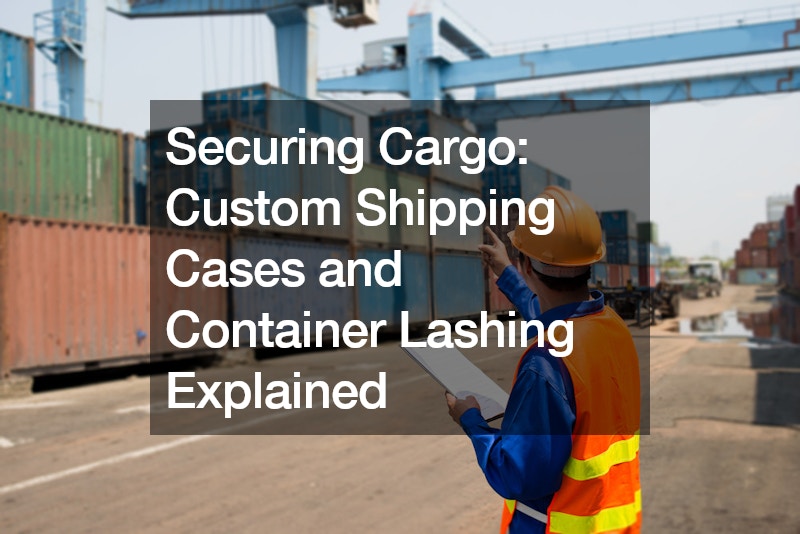In today’s globalized economy, efficient and secure cargo transportation is vital for businesses of all sizes. Whether you’re shipping delicate electronics across continents or heavy machinery domestically, proper cargo protection is paramount. This blog post delves into two crucial elements of secure cargo transportation: custom shipping cases and container lashing.
Understanding the Importance of Secure Cargo:
The consequences of improperly secured cargo can be significant, impacting businesses financially and reputationally. Here are some of the potential risks:
Product Damage: Unsecured cargo is susceptible to damage from vibrations, impacts, and shifting during transportation. This can lead to product malfunction, loss of inventory, and customer dissatisfaction.
Safety Hazards: Loose cargo can pose serious safety hazards during transportation. It can shift and break free, potentially injuring dockworkers or damaging other cargo. Shipping Delays: Damaged cargo may require inspection and repackaging, leading to delays and disrupting your supply chain. By investing in proper cargo securing techniques, businesses can effectively mitigate these risks and ensure their products arrive at their destination safely and on time.
Custom Shipping Cases: Tailored Protection for Valuables
Custom shipping cases offer a robust solution for protecting sensitive and valuable cargo during transportation. These cases are designed and manufactured to fit the specific dimensions and needs of your product.
Benefits of Custom Shipping Cases:
Superior Protection: Custom cases provide a snug fit, minimizing movement and protecting your product from vibrations, impacts, and environmental factors like dust and moisture. Durability: Built with robust materials like plywood, aluminum, or plastic, custom cases are designed to withstand the rigors of transportation. Branding Opportunities: Custom cases can be branded with your company logo and information, adding a professional touch and enhancing brand recognition. Types of Custom Shipping Cases:
Hard-Shell Cases: Offering the highest level of protection, these cases are ideal for heavy machinery, electronics, and other sensitive equipment. Soft-Sided Cases: Lightweight and portable, these cases are suitable for delicate instruments, medical equipment, or products requiring easy access. Flight Cases: Built for durability and frequent travel, these cases are commonly used in the entertainment industry and aviation sectors. Considerations for Choosing Custom Shipping Cases:
Product Dimensions and Weight: Ensure the case offers a snug fit and can accommodate the weight of your product. Material Selection: Choose a material that offers the appropriate level of protection based on your product’s needs. Transport Requirements: Consider the mode of transportation (air, sea, land) and any specific handling requirements. Container Lashing: Securing Cargo within Shipping Containers
Container lashing refers to the process of securing cargo within shipping containers using straps, tie-downs, and other specialized equipment.
Importance of Container Lashing:
Even within a sturdy container, cargo can shift and damage during transport if not properly secured. Container lashing ensures:
Cargo Stability: Prevents cargo from shifting or toppling over during transport, minimizing the risk of damage. Efficient Use of Space: Proper lashing techniques allow for optimal loading within the container, maximizing space utilization. Safety Compliance: International shipping regulations mandate proper container lashing to ensure safe transportation. Common Container Lashing Methods:
Direct Lashing: Straps or tie-downs are directly attached to secure points within the container and the cargo itself. Indirect Lashing: Dunnage (packing materials) are used to create a barrier between the cargo and the container walls, and lashing secures the dunnage. Corner Lashing: Uses specialized corner devices to secure cargo in all directions within the container. Choosing the Right Lashing Method:
The most appropriate lashing method depends on factors such as:
Cargo Type: Different types of cargo require different lashing techniques. Weight Distribution: The weight of the cargo needs to be evenly distributed within the container for optimal stability. Container Type: Different container sizes and configurations may require variations in lashing techniques. Conclusion:
Custom shipping cases and container lashing are two essential components of a successful cargo transportation strategy. By employing these techniques, businesses can ensure their products arrive at their destination safely, efficiently, and damage-free. Investing in proper cargo securing not only protects your products and brand reputation but also contributes to a safer transportation environment for everyone involved.
.




